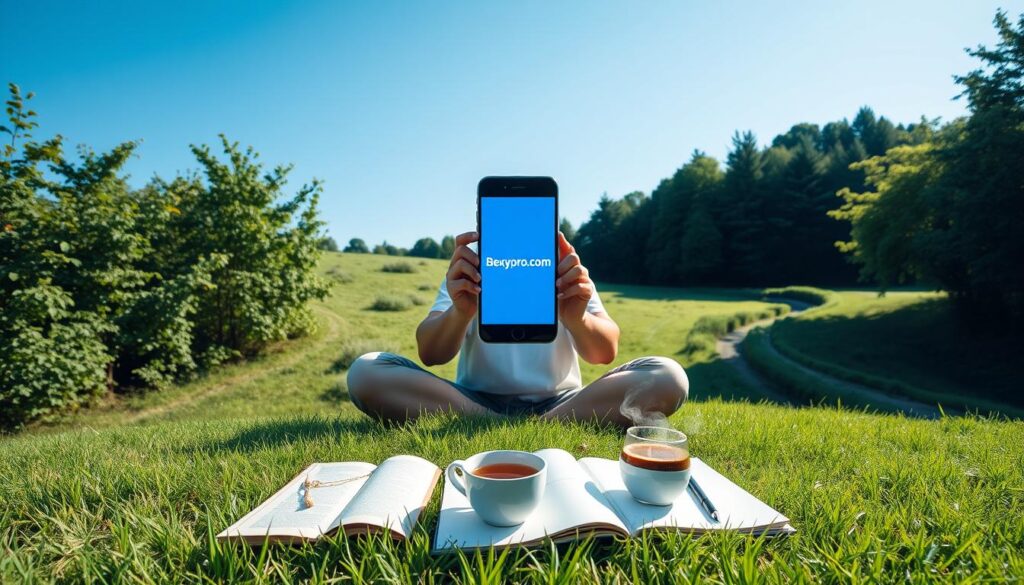Physical Address
304 North Cardinal St.
Dorchester Center, MA 02124
Physical Address
304 North Cardinal St.
Dorchester Center, MA 02124

Surprising fact: about 61% of people say they feel addicted to the internet and screens, and Americans now spend over 11 hours a day with media.
I’ve noticed this in my own life: my phone is often within reach, every swipe gives a tiny dopamine hit, and my focus fragments. That constant pull creeps into work, sleep, and relationships.
I define a practical digital detox as a way I can cut unnecessary use and re-center my attention without abandoning technology. It’s not perfection. It’s small, repeatable steps that add up.
In this guide I’ll explain why I’m choosing a detox now, share quick actions I can take, and show the benefits I can expect—better sleep, less stress, more productivity, and clearer communication with others.
My daily routine revealed a steady bleed of minutes and attention. I can point to habits that cost me sleep, mood, and focused work.
What my screen habits are costing me today
| Habit | Immediate Impact | Daily Cost (approx) | Why I’ll target it first |
|---|---|---|---|
| Doom-scrolling in evenings | Worse sleep | 45–90 minutes | High sleep and mood payoff when stopped |
| Refresh loops for email | Interrupted focus | 30–60 minutes | Easy to limit with notification cuts |
| Constant messaging | Work bleeds into life | 30–120 minutes | Restores boundaries and energy |
| Phone checks during meals | Lost face-to-face time | 15–30 minutes | Simple swap for presence |
Bottom line:these visible costs make a detox the sensible next step. I’ll document the worst habits and start with the highest-impact changes first.
Counting my app opens made it obvious how often I let notifications lead the day.

I define a digital detox as a planned period where I pause or cut back on phones, computers, tablets, TVs, and social platforms. The goal is simple: reclaim attention and reset habits so I use technology more intentionally.
It isn’t a full rejection of tools. I keep the functions I need and choose breaks that fit my life.
Nielsen data shows American adults now spend more than 11 hours a day with media. That many hours makes autopilot use easy and steals moments I want for rest, hobbies, and focus.
My commitment: I will watch triggers like notifications and transitions, respond with curiosity instead of judgment, and design small, flexible changes that fit my responsibilities.
Small breaks from my devices led to clearer thinking and steadier energy. I noticed the change within days when I paused habitual scrolling.

Lower stress and anxiety. Scheduled breaks cut information overload and stop the FOMO loop. With fewer inputs, my nervous system calms and I worry less about missing out.
I protect my sleep by avoiding late-night phone use. That supports melatonin release and helps me fall asleep faster. The National Sleep Foundation notes many young adults bring phones to bed, which links to poorer rest.
Fewer pings mean deeper work. When interruptions fall, I finish tasks faster and feel more accomplished by midday.
Less heavy smartphone use eased my eye strain, headaches, and neck tension. Regular pauses helped my posture and lowered physical fatigue.
Putting devices away in key moments improved conversations and presence. I also found that cutting social media to short, intentional sessions reduced loneliness and anxiety—research supports better mental health with limits on social platforms.
My plan begins with tiny, concrete swaps that fit my workday and weekend life. I want changes that stick, so I build habits that respect my job, school, and social duties.
I set realistic windows for email and messages instead of checking all day. Designated slots keep interruptions low and let me finish focused work.
I delay my first phone check by 15 minutes, then 30, and add half-day blocks on weekends. Small steps make a long change feel doable.
I turn off nonessential notifications and use Do Not Disturb during focus sprints. This reduces pings that break concentration.
I delete or hide apps that don’t help my well-being and keep the phone out of reach during meals, workouts, and before bed. That simple barrier cuts reflexive tapping.
Finally, I track usage with built-in tools so I can see progress, celebrate wins, and fine-tune limits as the day-to-day changes.
I need a plan that targets the habits that steal my focus most days. A short, clear plan plus tracking helps me keep gains and avoid slipping back into old patterns.
I write one-page rules that name my top problems: late-night scrolling, morning checks, and work-day distraction loops. I list device-free meals and set specific limits for social apps.
I pick measurable targets: 30 minutes of social media per day, two scheduled email blocks, and device-free dinners. These concrete goals make choices easy and fair.
I use phone settings and a simple third-party app to monitor hours and app opens. Seeing week-to-week usage helps me celebrate wins and tighten limits where needed.
After two weeks I check stress, sleep, focus, and productivity. I keep the changes that improve my life and relax rules that cause needless friction.
| Action | Measure | Goal | Follow-up |
|---|---|---|---|
| Social media | Minutes per day | 30 min/day | Reduce by 10% if benefits seen |
| Checks per day | 2 slots (morning, late afternoon) | Keep schedule; add autoresponder notes | |
| Device-free meals | Meals per week | All dinners, weekends mornings | Make it family habit; ask for support |
| Notifications | Alerts disabled | Only essential app alerts | Review monthly and adjust |
Final note: I treat this as a living plan. Small adjustments, tracking, and support from family or coworkers keep better habits in place and protect my mental health.
I’m closing this guide with a promise to guard my attention one step at a time.
I aim for a practical digital detox that returns meaningful hours in my day, lifts my mood, and protects my sleep and mental health.
I commit to small, consistent steps: plan device-free moments, turn off nonessential notifications, track my phone and devices use, and set one clear screen time limit each day.
The real benefits are real—lower stress and anxiety, better sleep, clearer communication, and stronger relationships. This is about healthier life, not perfection.
If habits feel unmanageable, I will seek support from my primary care or a mental health provider to refine the plan. Today I choose one action: a tech-free hour before bed to start building momentum.